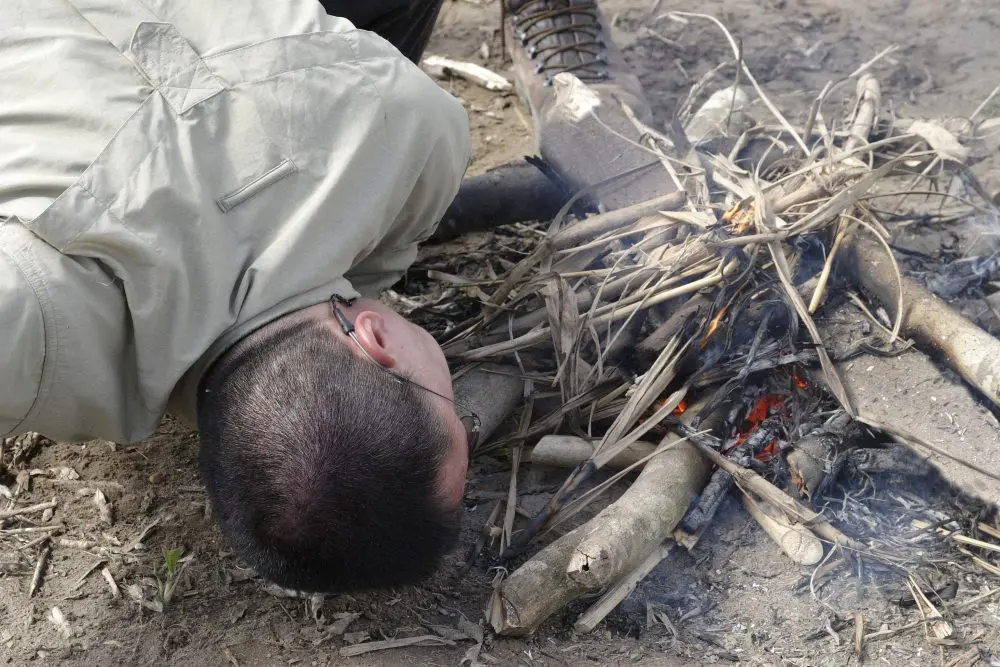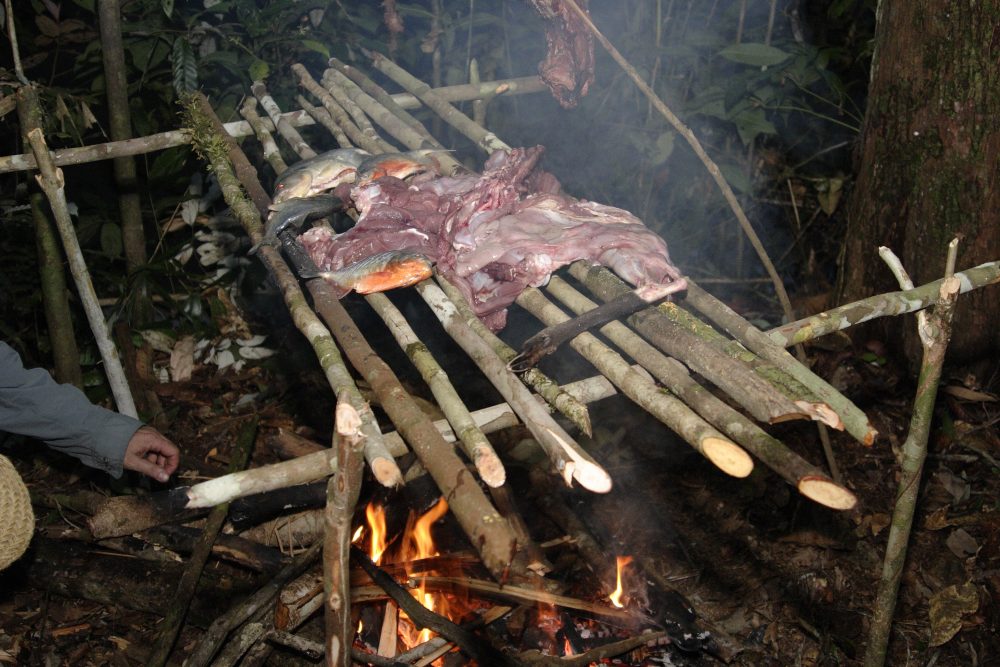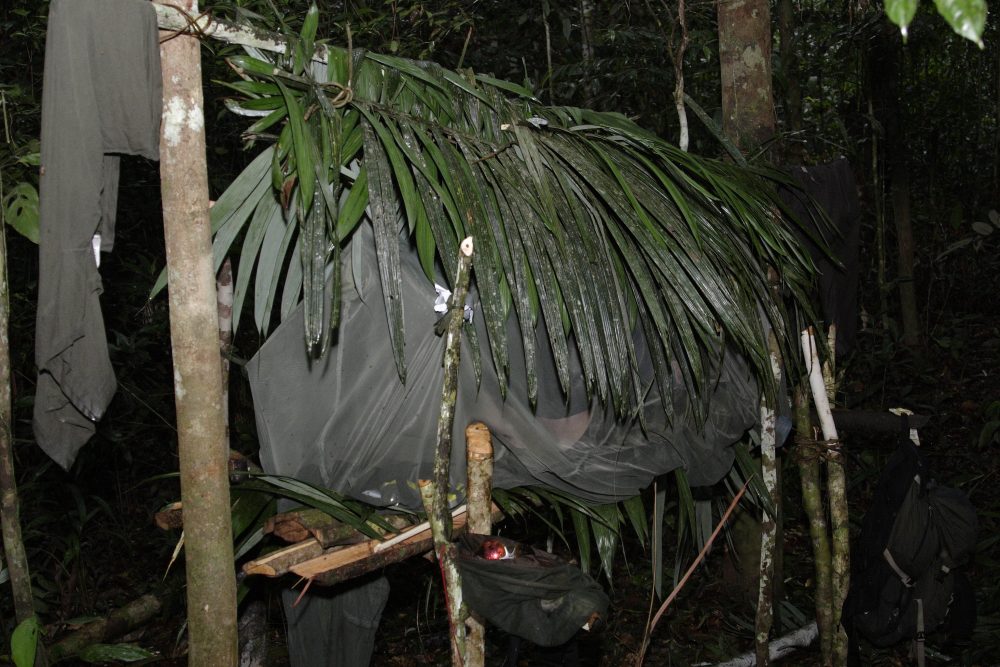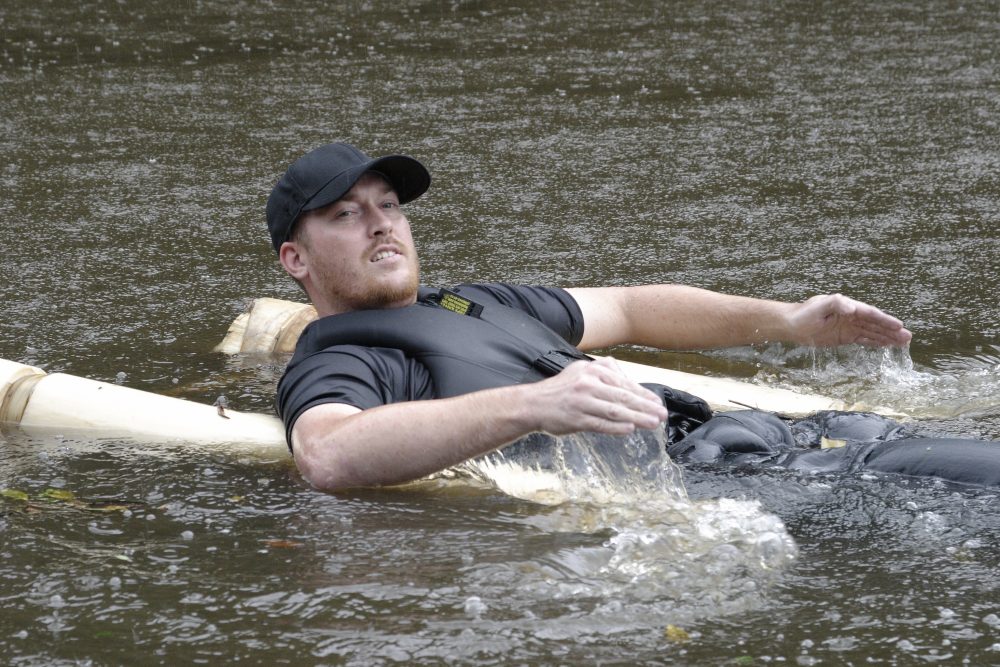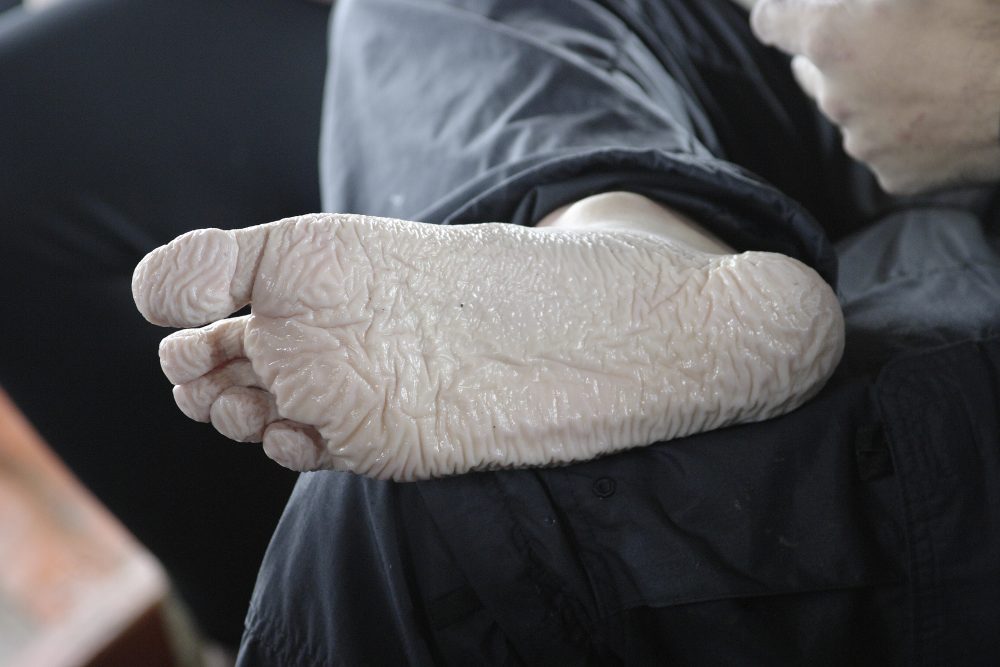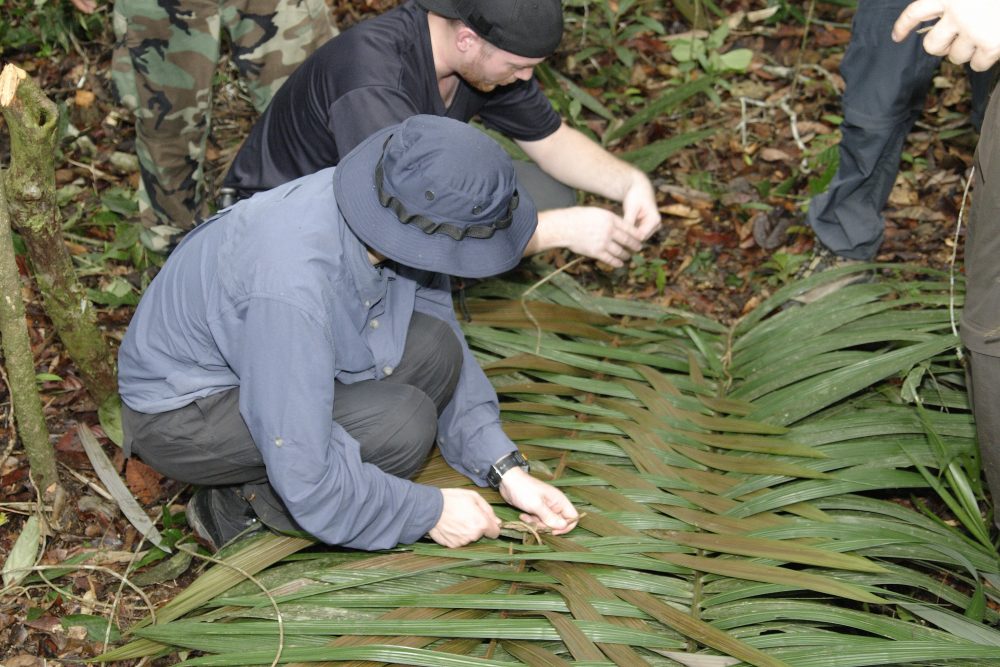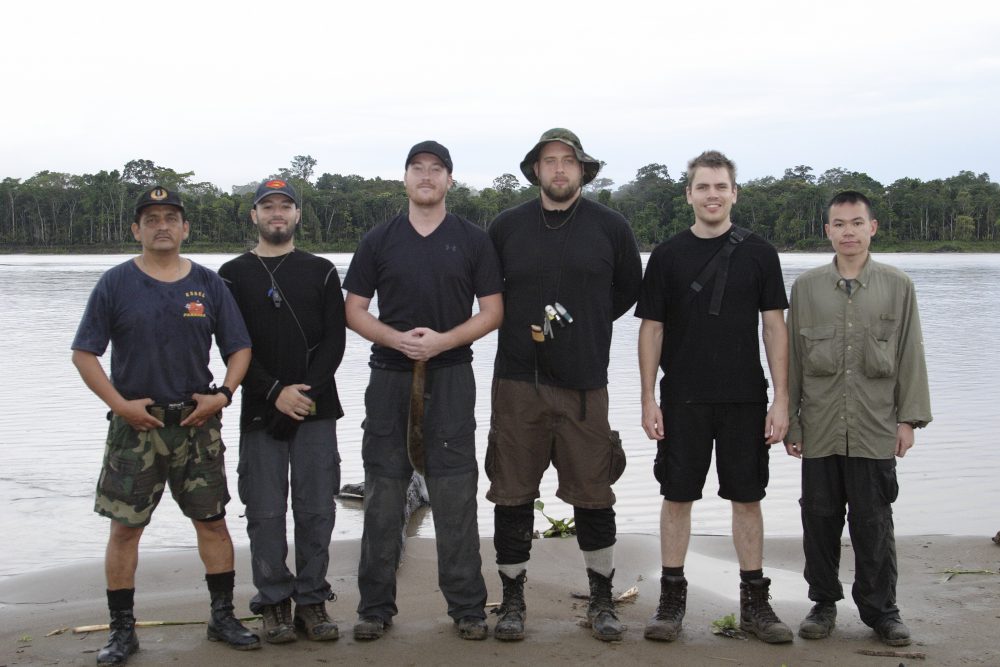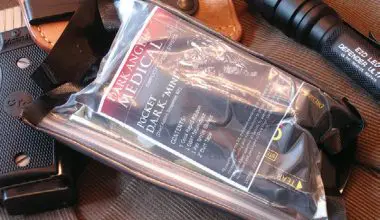When it comes to training, having to do something is a far better instructor than the comfort of knowing you can quit at any time and go home. The best teacher in the world is named “necessity.”
For the past 10 years my partner, Mike Perrin, and I have operated Randall’s Adventure & Training (RAT) Jungle Survival School which dumps unsuspecting city slickers in the middle of the Peruvian Amazon jungle and teaches them to get out alive.
Jungle barbeque of Piranha fish and a small deer taken for food.
Now, to keep this particular column from sounding like an ad for RAT’s jungle school, let me state up front that we make no claims that we run the best school or that our students go on to do great things with their lives. I won’t even claim that we know what we’re doing once we step outside of civilization. Instead I’ll leave it to our graduates, a few of which are contractors and government operators working in tropical zones, to determine the value of attending one of our courses. However, I do want to cover tropical survival in Against All Odds since S.W.A.T. readers may find themselves in a tropical jungle at some point. So, having just returned from our last class with fresh bug bites and new photos, I figured this was a great time to write up the subject.
So, what are the basic survival priorities should you become a victim of the jungle? If we factor out situations such as injury or having to escape/evade an enemy, then the initial priorities boil down to water, shelter, and navigation/signaling. Secondary priorities are fire building and nourishment. And somewhere in the mix, there is also the priority of keeping your mind and body in working order.
To help you along, your jungle survival kit should include a machete (or similar knife), water container, compass, signal mirror, mosquito net, poncho, foot powder, small LED light, basic fishing kit and fire starting kit. Most of these items are carried in a pilot’s survival vest, so any of you contractor pilots spraying industrial-strength Round-Up on coca plants in Colombia should already be good to go.
This jungle survival shelter consists of a swamp bed platform with mosquito net on top and roof made of palm fronds.
Table of Contents
WATER
One of the real dangers of tropical work is dehydration. Even with all the water in a jungle, most travelers always border on dehydration and have extremely low urine output. Staying hydrated is a must! Naturally, if you’re close to a river or stream, then drinking directly from them will keep you alive. If you have no means of purifying, don’t worry about it—you can worry about ridding your gut of bugs after you’re rescued.
If you’re not near a river, then look for plants that trap water. The jungle is full of large leafy plants that form natural bowls. Vines and tree roots are also natural providers. When cutting these, always make the top cut first, then cut at the bottom to remove a section of the vine or root, otherwise the plant will suck the water up and not leave much for you to drink. Only drink from plants that provide clear water and discard any vine or root that produces milky colored water. Good water vines and roots will produce up to a quart of water for every meter-long section, and the water will have a fruity, clean taste.
If it’s raining, use large leaves to make water traps for catching rainwater. You shouldn’t die from dehydration in a tropical jungle, since water is so plentiful, whether it’s in the rivers, from the sky, in the ground or in the plant life.
Getting a fire started in the humid areas of the Amazon jungle is one of the most difficult survival skills to learn. Student blows fire to life on banks of jungle river.
SHELTER
If you’ve never been in a jungle before, then the war taking place on the jungle floor may surprise you. Ants, bugs and creatures of all types are constantly moving and fighting to stay alive. If the ants or termites don’t take over your body, the rest of the insect world (and some mammals and reptiles) will. Sleeping on the ground with no shelter is not an option, as Les Stroud found out on his Costa Rica jungle segment of Survivorman. In a jungle survival situation, you have to be able to rest, and the best way to do that is on a raised sleeping platform known as a swamp bed.
To build one, simply push four forked sticks into the soft jungle ground with each stick being at the corner of your bed. Cut two saplings about 2 inches in diameter and a little longer than the width of your bed. Lay one of these sticks in the forks of your support poles at the head of the bed, and then do the same thing at the foot with the other sapling. Now cut saplings (approximately 2 inches in diameter) that are a little longer than the length of the bed, and “floor” the whole bed by laying these on top of the cross saplings at the head and foot. If needed, the whole bed can be supported and braced against trees and lashed with the soft vines that are plentiful in the jungle. Once you’re finished, you can make a mattress out of palm fronds by splitting them down the middle and turning the middle (spine) sections toward the outside.
Jungle survival student uses his jungle-built raft to escape the jungle by floating downriver and back to civilization.
A waterproof shelter top can be made by lashing a sapling between two trees over your bed, then covering it with palm fronds, either woven together to make them wider or stacked on top of each other and lashed in place. You can also improvise shelters using a poncho (if available) as your roof. If you have a mosquito net, support it from underneath the roof and you’ve got yourself a comfortable night’s sleep. Even without a net, it’s much better than even considering sleeping on the ground.
While I’m on the subject of constructing shelters, be sure to avoid any tree that may have thorns, ant nests or other dangers attached to it. The jungle is full of them, and palms such as the Black Palm can wreak havoc on your well-being, so stay aware when searching for materials. The Black Palm is only the nastiest tree in the jungle with four-inch spikes protruding all the way around and up the tree. One screw up and you have a serious wound in your leg, hand or other part of your body.
Protecting your feet is imperative in a jungle environment. This student wore wet boots for two days without removing them, thus inviting bacteria and disease to enter his feet, as well as pain and swelling from water infusion.
NAVIGATION
If you stay trapped in a jungle long enough, it will finally win by attrition. The only way to survive is being able to navigate out, since waiting on rescue is generally not an option. Almost every jungle Search And Rescue (SAR) team will tell you that it’s almost impossible to find a person from the air. Even in airplane crash scenarios, primary jungle canopy closes up quickly and only the most skilled eye is able to find where the crash occurred. If you get lost, survive a crash or get left behind in primary jungle, your ability to survive will almost assuredly rest solely on your ability to navigate out.
One bit of survival lore that does work in most jungles is that rivers almost always lead to civilization. If you can find a stream or river, keep following it downstream and you will eventually find some form of civilization. Rivers are a jungle’s lifeblood. If you find one, stick with it until you’re rescued, since a river will be able to feed you, hydrate you, provide you with easy transportation (via simple rafts), as well as giving you an open spot for signaling SAR teams.
If you have no river to navigate by, then use your compass to maintain a straight bearing. Hopefully, you have an idea of a general direction that crosses a river, road or civilization. If not, then pick a course and stick with it until you find something. If you have no compass, then you will have to do your best at using the sun to keep you traveling in a straight line. There are many methods that can be used, such as a shadow stick and using an analog watch as a makeshift compass for gross direction. My advice is to never enter any tropical area without a compass. GPS systems are good as long as the batteries hold up, but in triple canopy they sometimes fail to get good reception—do not rely on any electronic navigation device! Buy a good compass, learn how to use it and keep it on you.
RAT jungle school participant eats Suri grub worms found in Amazon jungle.
FIRE
Fire is important as a comfort tool when you’re alone in a dark jungle with insects crawling up your leg and making your evening a living hell. It’s also necessary for cooking food that you may catch or trap. With that said, fire doesn’t come easy in most jungles.
If anyone thinks they’re a “Fire God” and can start a fire anywhere, under any conditions, I would love to haul them to the Peruvian Amazon for a little practice. I’m a pretty good fire starter. In fact, I probably border on being a pyromaniac, but the Amazon jungle has always been an extremely challenging environment for me to consistently start fires. In fact, the one Les Stroud Survivorman show that I called BS on was his ease at starting a fire in the jungle. It just doesn’t happen as easily as he made it appear. The best advice I can give you is to keep a good fire kit. A lighter, ferrocerium rod, plenty of cotton balls soaked in Vaseline, any type of plastic that will burn, gelled alcohol, egg crates filled with wax and even a few piece of fat wood will most certainly help you to get a fire going.
If you don’t have any of that, then you can try to use the Amazon Indian trick and find a Copal tree. If you can locate it, the amber to black colored globules of sap found on the outside will light instantly and burn for a long time. If all else fails and no quick cheater methods are available, then we always resort to finding standing dead wood and scraping thin slivers of this wood with our machetes. Once we get a large tinder bundle, we light it up and then start feeding it as the fire builds.
Fire building in a wet jungle is hard. In fact, as our last jungle school participants found out, it’s perhaps the most difficult skill to master in this jungle environment. Make sure you have a good kit if your travels involve wet jungles.
Weaving palm fronds for shelter roof and securing them together with jungle vine.
NOURISHMENT
This is the least of my jungle survival priorities. In a hot, humid environment you will find the “hunger factor” goes away, and your body will go a long time on minimal calories, as long as you can get rest and stay hydrated. Although we know this fact, we still take every opportunity to eat when possible. Fishing is a relaxing, easy method of nourishment in a jungle. There are also many edible insects such as the large grubs known as “Suri.” These worms are plentiful in the jungle, have a high nutritional value and are easy to find in rotting palm trees. Eat them live or roast them on a stick over a fire.
The hearts of palm trees (swamp cabbage) make a great comfort food that tastes good, although it offers little nutritional value. There are also numerous nuts and edible wild fruits, but unless you absolutely know what you’re looking for, forget about foraging for plants to eat. I don’t trust plant edibility tests, since it’s too easy to poison yourself. If you can’t find something to eat, then don’t worry too much, since it takes a human a long time to die of starvation. Stay hydrated and stay motivated.
August ’07 RAT Jungle Survival Class with Peruvian Air Force Special Forces Instructor (L) on banks of Amazon River.
STAYING PHYSICALLY AND MENTALLY HEALTHY
Keeping your feet healthy is a top priority in the jungle. Any chance you get, take off your boots, wash your feet and dry them the best you can. If you have foot powder, use it. The jungle wetness and grime have a way of turning your feet into mush and eventually crippling you. Protect your feet! If you can’t walk, you die. Also be sure to take a bath every so often if you’re around a river. Not only do the tannins in the water cleanse your body of bacteria and germs, but a bath also re-energizes you mentally. The jungle has a way of wearing on you after you spend enough time in it. Being hungry, dirty, eaten alive by bugs, tired, sweaty and overwhelmed by the same green vegetation day after day can make you a little crazy.
Try to stay motivated and remember that the jungle is one of the easiest places in the world to physically survive in. Don’t dwell on how long you’ve been in the forest. Set small, attainable goals and keep moving forward.
There’s an old saying among jungle dwellers, “The jungle either accepts you or spits you out.” During my years of traveling there, I’ve seen it spit more than a few people out, but all of them, without fail, have been spit out by their lack of ability to mentally cope with it, not due to a physical inability.
[Jeff Randall has worked and traveled in China, Korea, Malaysia, Indonesia, Singapore, Switzerland, and nearly every Latin American country. He is the co-author of the book Adventure Travel in the Third World and is also an accomplished photographer. He considers the Amazon jungle his second home. He can be contacted through www.jungletraining.com]
